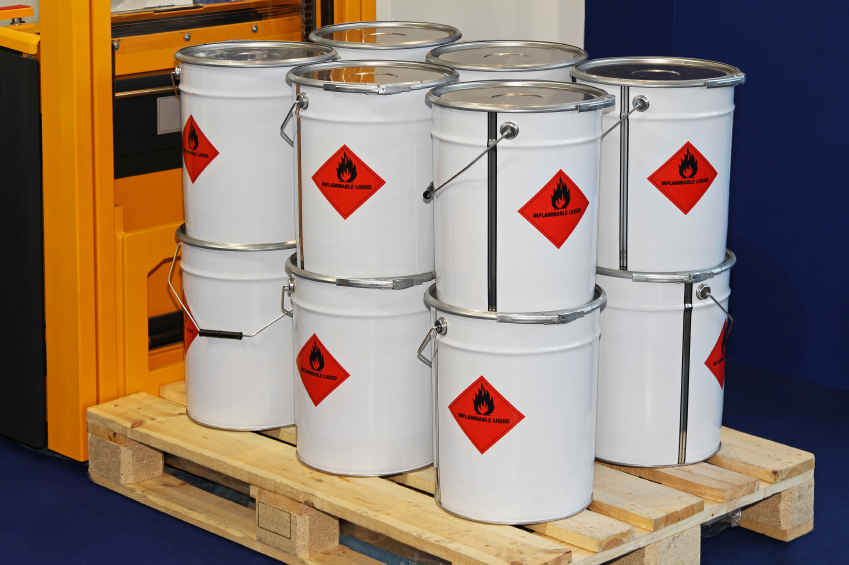
|
Storage requirements are also affected by the quantity of chemicals being stored and by whether they are stored inside or outside. Keep reading for more information on safe storage of flammables.
Large Quantity Storage
How you store your flammables will be affected by the amount you need to store. If you’re storing large quantities of flammables (see below for a discussion of the maximum amount of flammable liquids you can store in a storage cabinet or portable tank), you’ll either need specially constructed indoor or outdoor storage areas, or permanent tanks and piping systems built to comply with the extensive requirements found in 1910.106.
Small(er) Quantity Storage
Flammable liquids must be stored in closed containers. Smaller quantities of flammable liquids can be stored in approved containers and portable tanks.
- Up to 1 pint of a Category 1 flammable liquid, or 1 gallon (gal.)of a Category 2–4 flammable liquid, can be stored in a glass or approved plastic container.
- Up to 1 gal. of a Category 1 flammable liquid, or 5 gal. of a Category 2–4 flammable liquid, can be stored in a metal container (other than a Department of Transportation (DOT) drum).
- Up to 2 gal. of a Category 1 flammable liquid, or 5 gal. of a Category 2–4 flammable liquid, can be stored in safety cans.
- Up to 60 gal. of any flammable liquid can be stored in a metal DOT-approved drum.
- Up to 660 gal. of any flammable liquid can be stored in an approved portable tank.
The table below offers a visual summary of OSHA’s limits for small-quantity storage of flammables.
Your one-stop safety management resource, available 24/7. Go here to take a no-cost site tour or here to try it in your own office!
Maximum allowable sizes of containers and portable tanks for flammable liquids
|
Container type |
Category 1 |
Category 2 |
Category 3 |
Category 4 |
|
Glass or approved plastic |
1 pint |
1 quart |
1 gal. |
1 gal. |
|
Metal (other than DOT drums) |
1 gal. |
5 gal. |
5 gal. |
5 gal. |
|
Safety cans |
2 gal. |
5 gal. |
5 gal. |
5 gal. |
|
Metal drum (DOT spec.) |
60 gal. |
60 gal. |
60 gal. |
60 gal. |
|
Approved portable tanks |
660 gal. |
660 gal. |
660 gal. |
660 gal. |
In addition to the restrictions on the sizes of flammables storage containers, there are restrictions on the total amount of flammable liquids you can store in a single area. The quantity of liquid that may be located outside of an inside storage room or storage cabinet in a building or in any one fire area of a building must not exceed:
- 25 gallons of Category 1 flammable liquids in containers;
- 120 gallons of Category 2, 3, or 4 flammable liquids in containers; or
- 660 gallons of Category 2, 3, or 4 flammable liquids in a single portable tank.
Great news! BLR’s renowned Safety.BLR.com® website now has even more time-saving features. Take our no-cost site tour! Or better yet, try it at no cost or obligation for a full 2 weeks.
If you need a storage cabinet, it must be made to OSHA’s specifications, and you may not store more than 60 gal. of Category 1, 2, or 3 liquids, nor more than 120 gal. of Category 4 liquids, in a storage cabinet.
Metal cabinets for storage of flammables must be constructed in the following manner (29 CFR 1910.106(d)(3)(ii)(a)):
- Bottom, top, and sides of cabinets must be at least No. 18 gauge sheet steel.
- Cabinets must be double-walled with 1½-inch airspace.
- Joints must be riveted, welded, or made tight by some equally effective means.
- Doors must have a three-point latch.
- Door sills must be raised at least 2 inches above the cabinet bottom to retain spilled liquid within the cabinet.
- Cabinets must be labeled in conspicuous lettering “Flammable—Keep Fire Away.”
Wood cabinets must be constructed in the following manner (29 CFR 1910.106(d)(3)(ii)(b)):
- Bottom, top, and sides of cabinets must be constructed of exterior grade plywood at least 1 inch thick.
- Plywood must not break down or delaminate under fire conditions.
- Joints must be rabbeted and fastened in two directions with flathead wood screws.
- When more than one door is used, they should have a rabbeted overlap of not less than 1 inch.
- Doors must be equipped with latches and hinges that are mounted to not lose their holding capacity when subjected to the fire test.
- Cabinets must be labeled in conspicuous lettering “Flammable—Keep Fire Away.”
Need additional information on chemical storage? You’ll find it at Safety.BLR.com®.
